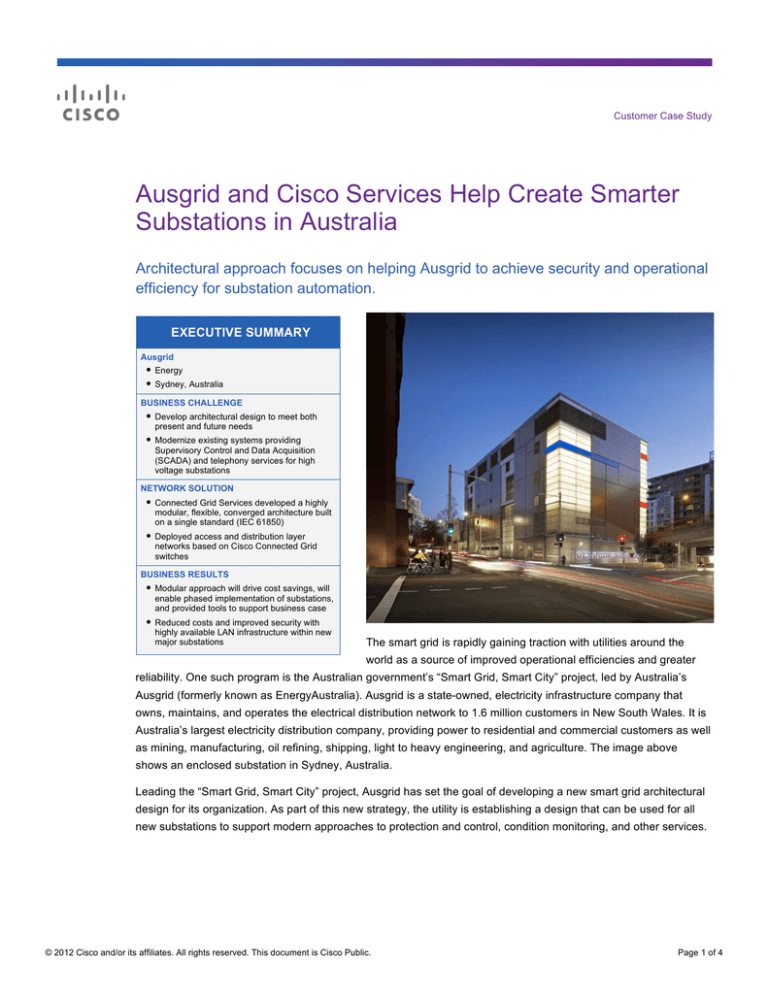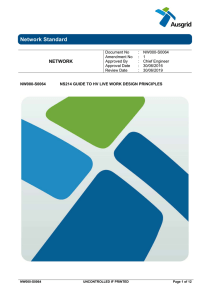
Customer Case Study
Ausgrid and Cisco Services Help Create Smarter
Substations in Australia
Architectural approach focuses on helping Ausgrid to achieve security and operational
efficiency for substation automation.
EXECUTIVE SUMMARY
Ausgrid
● Energy
● Sydney, Australia
BUSINESS CHALLENGE
● Develop architectural design to meet both
present and future needs
● Modernize existing systems providing
Supervisory Control and Data Acquisition
(SCADA) and telephony services for high
voltage substations
NETWORK SOLUTION
● Connected Grid Services developed a highly
modular, flexible, converged architecture built
on a single standard (IEC 61850)
● Deployed access and distribution layer
networks based on Cisco Connected Grid
switches
BUSINESS RESULTS
● Modular approach will drive cost savings, will
enable phased implementation of substations,
and provided tools to support business case
● Reduced costs and improved security with
highly available LAN infrastructure within new
major substations
The smart grid is rapidly gaining traction with utilities around the
world as a source of improved operational efficiencies and greater
reliability. One such program is the Australian government’s “Smart Grid, Smart City” project, led by Australia’s
Ausgrid (formerly known as EnergyAustralia). Ausgrid is a state-owned, electricity infrastructure company that
owns, maintains, and operates the electrical distribution network to 1.6 million customers in New South Wales. It is
Australia’s largest electricity distribution company, providing power to residential and commercial customers as well
as mining, manufacturing, oil refining, shipping, light to heavy engineering, and agriculture. The image above
shows an enclosed substation in Sydney, Australia.
Leading the “Smart Grid, Smart City” project, Ausgrid has set the goal of developing a new smart grid architectural
design for its organization. As part of this new strategy, the utility is establishing a design that can be used for all
new substations to support modern approaches to protection and control, condition monitoring, and other services.
© 2012 Cisco and/or its affiliates. All rights reserved. This document is Cisco Public.
Page 1 of 4
Ausgrid anticipates that this approach will provide the following benefits:
●
Reduced capital and operating costs for substations and infrastructure
●
Improved reliability due to condition-based maintenance
●
Improved efficiency through mobility and field workforce collaboration applications
●
Reduced third-party costs through new network services such as IP telephony in the substation
●
Improved physical and network security for operations
“Ausgrid’s goal is to test the commercial success of these technologies, share our findings, and build a business
case for change,” said Adrian Clark, Ausgrid’s Chief Technology Officer. “This pilot is designed to show how smart
network infrastructures can help Ausgrid create a new, more efficient system for providing utility services.”
“We liked the knowledge set and mix of skills that Cisco’s experts
brought to the table. We knew that Cisco would develop findings that can
be leveraged for our architectures, and that this intellectual property can
then be fed back into the lifecycle to help us expand the substation
network effectively.”
— Philip King, Operational Technology and Innovation Development Manager, Ausgrid
Building the Knowledge Base with Cisco Services
Ausgrid selected Cisco Services based on its previous experience in similar international projects to assess
business needs and design a substation communications architecture. “We liked the knowledge set and mix of
skills that Cisco’s experts brought to the table,” said Philip King, Ausgrid’s Operational Technology and Innovation
Development Manager. “We knew that Cisco would develop findings that can be leveraged for our architectures,
and that this intellectual property can then be fed back into the lifecycle to help us expand the substation network
effectively.”
This project was carried out in three phases:
●
Requirements gathering and use case development: This phase included extensive interviews with
stakeholders and use case and application owners. The Cisco team performed a series of onsite workshops
to support a set of extensive business, process flow, and communications flow analyses.
●
Architecture development: Based on the use cases and requirements, the team developed an optimal
design for the organization to meet both present and future needs. This included protection and control,
as well as functions such as automation, physical security, corporate traffic, cyber security, and overall
network management.
●
Integration planning: Finally, the team developed planning documents that set a standard for integrating
the new architecture into the overall organization, as well as provisions for ongoing testing, support, and
monitoring.
© 2012 Cisco and/or its affiliates. All rights reserved. This document is Cisco Public.
Page 2 of 4
Outdoor Substation in Newcastle, New South Wales, Australia
Throughout this project, the team leveraged Cisco’s GridBlocks Architecture development methodology, a rigorous
program developed to extract and define business requirements, map these to specific communications needs,
and deliver an optimal architectural design. Experts worked closely with Ausgrid to capture use cases across the
business, aggregate relevant metrics, and create a suite of deliverables, including strategies for testing, production
support, network integration, and holistic implementation.
Based on these detailed findings, Cisco Services developed a proposal for a scalable, highly modular, flexible
architecture supporting a single standard (i.e., IEC 61850). This modular approach supports further cost savings,
enabling larger implementation for major substations and smaller deployments for remote sites supplying fewer
customers. The design also allows for a phased implementation for new substations and a retrofit for existing sites.
The Cisco team supported these design concepts with a set of technical and business requirements, as well as
providing input for a cost-benefits analysis.
“Cisco was able to bring their knowledge of standards and the industry to
help fill a skills gap beyond traditional electrical engineering for power
utilities. Their work is assisting us to transform the electricity network into
a smarter grid. We highly value their ongoing partnership and
commitment to our company and the industry.”
— Adrian Clark, Chief Technology Officer, Ausgrid
“The Cisco team went to great lengths to do the research and document the underlying business drivers,” King
said. “This helped us develop relationships with internal stakeholders and ensure that they bought in to the project
concept. We were very happy with the services provided and the quality of the work.”
© 2012 Cisco and/or its affiliates. All rights reserved. This document is Cisco Public.
Page 3 of 4
Results and Next Steps
Ausgrid is building ten major substations every year in one of Australia’s biggest infrastructure programs. Cisco
was asked for communications equipment tough enough for very hot and humid conditions in substations as part of
Ausgrid’s transforming the electricity network into a smart grid. Cisco Connected Grid routers and switches create
a reliable multi-service network in the substation. These industrial-grade routers and switches are designed for the
substation harsh environment, and are compliant to industry standards including IEC-61850-3 and IEEE-1613.
The work performed by Cisco Services has established the direction for substation communications at Ausgrid over
the next ten years, according to Clark.
“Cisco Services worked with Ausgrid to bring their expertise in the telecommunications industry to understand
the requirements for electricity substations today and as we move towards a more complex and integrated
future environment,” Clark said. “Cisco was able to bring their knowledge of standards and the industry to help fill a
skills gap beyond traditional electrical engineering for power utilities. Their work is assisting us to transform the
electricity network into a smarter grid. We highly value their ongoing partnership and commitment to our company
and the industry.”
Printed in USA
© 2012 Cisco and/or its affiliates. All rights reserved. This document is Cisco Public.
C36-704829-00
04/12
Page 4 of 4




